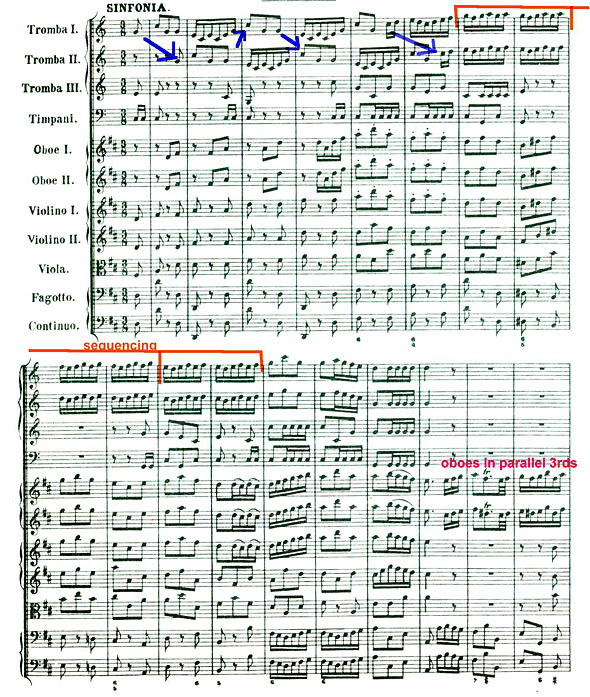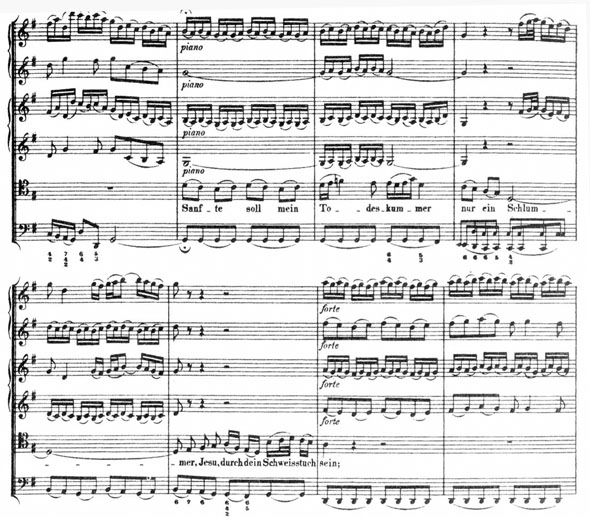This is the third work for which Bach employed the term “Oratorioum”, the other two being the Christmas Oratorio and the Ascension Oratorio. None of these works is dramatically dissimilar to what Bach calls in other situations “cantata”, except that the Christmas Oratorio is actually a set of six distinct cantatas.
In modern times, we tend to think of an oratorio as a sort of sacred opera, in that there are distinct characters, a clear story being told through the text and music, a longer length than cantatas and other sacred works, and a rather dramatic feel to the music. But this impression comes primarily from the English Oratorios of Bach’s contemporary, Georg Friedrich Handel. The 18th-century German oratorio developed at the same time as opera in Hamburg and Dresden, and used a biblical subject and sometimes even a biblical text. Chorales were often included, and choruses were prominent, though the most distinctive feature may have been the succession of many solo arias and recitatives. Thus, Bach’s oratorios stand apart from the “normal” oratorios of that time and place, not entirely cantatas and yet not really like other oratorios of the time. It is, therefore, not entirely clear why Bach and/or his librettist chose to use the label “Oratorium” in crafting these three works. (Simaon Heighes,The Oxford Companion to Bach.
Music of the music of the Easter Oratorio originated in 1725 in Bach’s cantata Entflieht, Verschwindet, entweich ihr Sorgen, which was written for the birthday of Duke Christian of Saxe-Weissenfled. It was transformed a mere month later – using newly composed recitatives and new text (probably by Picander) – into an Easter cantata. The following year, Bach morphed the cantata once again for a birthday celebration, this time for Count Joachim Friedrich von Flemming (BWV 249b), before it finally emerged in 1735, reworked and expanded as the Easter Oratorio. (See Simon Heighes, in The Oxford Companion to Bach, “Easter Oratorio”.)
The present work, the Easter Oratorio, is longer than an average Sunday cantata, numbering eleven movements and lasting approximately 40 minutes, depending on the tempos during the performance. The instrumentation is also large, including the usual strings and continuo, but also three trumpets, timpani, two oboes, bassoon, two flutes, and one oboe d’amore. (The flutes and oboe d’amore are used in some interior movements, whereas the trumpets and timpani – always appearing together – are used in the opening and closing.)
The work opens with a two-movement sinfonia, itself an unusual opening in that respect alone. More often, we are used to seeing a single instrumental movement as the sinfonia. But Bach here writes contrasting fast and slow movements for the ensemble. The first movement, in triple meter, features contrasting and alternating timbres with the trumpets and timpani dominating in one case, and the oboe – much different both in volume and tone – in the other. The combined use of trumpets and timpani is not unusual, though we tend to think more often of this enhancement to the ensemble occurring in the middle and latter parts of the 18th century, particularly in the pre-Classical and Classical eras. In any event, the timpani could not be returned quickly, as they can with foot pedals in modern times; the drums therefore had to be set to certain pitches before the performance began. Their use was thus limited to only 3 or 4 pitches, most commonly the tonic and dominant pitches. The two create a majestic, regal, or bright sound, and are rarely heard in slow movements.
Getting back to the present sinfonia – the first movement is in fast triple meter. It begins with the strings and oboes filling out the texture while trumpets I and II echo each other. The third trumpet and timpani also add to the texture, but do not play a lead role. By contrast, the oboes play in parallel thirds and the rhythmic unison, providing each other with the reinforcement again the large texture. (The excerpt below also shows an excellent example of a sequence, a common technique for unraveling a musical passage.) This opening trumpet melody – with the trumpets taking turns on the main melody – occurs five times in this first movement, and provides inspiration for other material throughout the movement.

The second movement – a functional continuation of the sinfonia – is slow, and therefore drops the trumpets and drums. Instead, a single oboe is featured in long, luxurious lines, plaintively singing above the strings and continuo, which always appear in this movement in rhythmic unison. The movement continues in triple meter (though here in 3/4 rather than 3/8), but shifts to b minor, the relative minor key of D major which served the opening movement. Without the trumpets and drums, with the slower tempo, and with a minor key, this movement is a stark contrast with its predecessor. The overwhelming joy of the Easter miracle disappears for a moment, perhaps as a reminder of the great sacrifice (Christ’s death on a cross) to bring about that joy.
The subsequent movement returns to D major and 3/8 meter, and the trumpets and drums rejoin the ensemble. Though eventually the voices will join in this movement, this third movement serves primarily to close out the sinfonia, which is written in typical Italian fashion – three movements, running fast-slow-fast. (This structure and format is typical of Italian operas of the Baroque era, and eventually leads to the development of the sinfonia as an independent 3-movement work – and to the development of the modern symphony.)
In the solo and duet movements that follow, Bach has clearly identified characters from the Easter story – Mary Magdalene, Mary of James, and the apostles Peter and John. The first recitative pits the two Marys, who continue to love their Lord and savior, against the troubled grieving men who are too sorrowful to support themselves or tend to the Lord’s body. Mary of James sings, accompanied by solo flute and continuo, of the joy in her heart as she tends to her Savior. For such a short text (a mere five lines), it is a long sumptuous movement. A trio sonata texture, both the obbligato solo flute and the soprano solo are highly ornate; despite the minor key (it is set in b minor), Bach creates a sense of hope (=anticipation of the resurrection) in the light sounds of soprano and flute, in the elaborate melodic lines, which more often rise than fall.
Another recitative follows, this one quite short (only nine measures). Peter and John have arrived at the tomb and are distraught at finding the stone has been rolled away and that Jesus’ body is gone. Mary Magdalene informs them that Christ is risen. Peter responds, saying he is overjoyed, but his music reveals his disbelief, cadencing again in b minor. The aria which follows is for Peter alone, as he reflects on death now being no more than slumber. “Sanfte sol mein Todeskummer” is itself something of a lullaby, with rocking motion in the flutes and violins, and oft-repeated pitches in the continuo to create something of a static feel.

This movement is the centerpiece, both literally and figuratively, of the oratorio: following it are four more movements, and preceding it were four vocal movements (plus the two movements which were solely instrumental); more importantly, it is the point at which Peter accepts the resurrection of Christ and realizes that death no longer has meaning, except as a means to entire eternal life.
After the G major of Peter’s aria, the music turns towards minor again for the subsequent recitative – a duet for the two Marys. Their use of minor is not disbelief, nor sorrow; rather it reflects a desperate, burning desire to see their Lord and Savior again. Mary Magdalene expands on this in the next movement, as she begs to know where to find Jesus, her beloved Lord. Supporting this, the music picks up tempo and returns to a major key, this time A major. John reflects her joy in the next recitative. Affirming that they all (all the apostles , and, presumably, all believers) rejoice in the resurrection. Almost at his direction (“turn to joyful anthems”), the trumpets and drums return for a triumphant chorus to close the work (“Praise und Dank” – Praise and Thanks). The chorus, having been silent since the third movement, provides reflection on the overall message of Easter: joy, hope, praise, thanks to God; the triumph of life over death; the opening of heaven; the banishment of Satan.


































